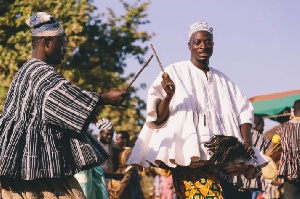 Traditional dancers wearing a batakari
Traditional dancers wearing a batakari
Many Ghanaians, but especially those from the north of the country, must have been taken aback and sorely disappointed with an announcement late last year that a national “Batakari Day” was to be launched at a ceremony at the offices of the World Bank Ghana in Accra.
Here was an important national event during and after which an exhibition of still and motion photography was supposed to showcase the culture of the people of Northern Ghana- their traditional wear, food, music and dance, and no one appeared to know that the traditional wear of the people of northern Ghana was NOT the batakari but the “fugu” or smock!
That the planned event which was expected to be a month-long exhibition and celebration of the culture of Northern Ghana was being sponsored by no organisation other than the native Savannah Accelerated Development Authority {SADA}, made the blunder most appalling to put it mildly.
It can only be hoped that the Ministry of Trade and Industry, the Ministry of Tourism, Culture and Creative Arts, the Ghana Investment Promotion Centre and the World Bank Group, which are collaborating in sponsorship of the event, will take careful note of the blunder and make amends as the event progresses.
The precise wording of the announcement according to one media report was that “the Ministry of Trade and Industry and the Savanna Accelerated Development Authority are set to conclude a policy document to declare the first Friday of every month Batakari Day”.
The fugu is often confused with the batakari, but while the batakari is made up of a flowing gown and trousers of varied fabrics, the all-cotton fugu is a hand-woven, plaid tunic-like shirt.
The “dansiki” is an adaptation of the formal or functional smock design. The “dansiki” is more loose-fitting and almost sleeveless. It is suitable for the hot, dry season.
To distinguish between traditional royalty and citizens of the north, smock producers produce “royal smocks” which are for chiefs. These come with a cap, trousers and knee-length leather boots.
Types There are various types of traditional smocks peculiar to various traditional areas of Northern Ghana which produce the bulk of the nation’s traditional smocks. There are generally three traditional smock designs identified with the country’s Northern, Upper East and Upper West regions.
The country’s Upper West Region is known for producing the best “cool colour” smocks. These generally combine different shades of blue and green or both colours with other “quiet colours” such as yellow, white, blue and green.
The Upper East Region is noted for “warm colour” smocks in which various shades of red or orange dominate other colours of the fabric. The Northern Region is noted for its “heavy duty” smocks-so called because of their generally large size and heavy fabric.
There are now various designs of traditional smocks for different occasions such as festivals, the performance of rituals funerals, weddings, child- naming ceremonies, as well as for leisure wear and informal occasions.
The fugu may incorporate two or more colours. Some common colour combinations are red, blue and white, black and white only, green, and white, green and red, deep or light black and white etc.
The fugu has a wide range of embroidery on the front, back and around the neck, most of them quite startlingly artistic. The typical colour for smock embroidery is white.
The wide range in quality of smocks is reflected in the range of prices, which may be as moderate as GH¢100 cedis or up to several hundred cedis. Traditional trousers and a cap to match will usually raise the cost of the traditional outfit considerably.
Fugu not batakari! In an ingenious blending of African and Western cultures, many public officers and dignitaries are wearing the smock over shirt and tie, and how they blend with a distinguished uniqueness!
Thanks to this exposure, the average tourist or foreign visitor to Ghana who leaves the country without at least one traditional smock in his luggage is probably an exception these days.
Tourist Ryan Coelho could not hide his fascination with “the feeling of power that comes with wearing a great smock”. “I swear when you put a smock on, you feel larger than life! You feel empowered! It’s great!” he declared. He recounts how he went shopping for a smock at Navrongo in the Upper East Region, just before he left Ghana: “The smocks were in all sorts of colours, patterns and styles. How they {fugu weavers} create such incredible pieces of work mostly by hand and from just thread is still beyond me.”
The smock industry is heavily dependent on the local cotton industry. Through many generations of smock producers, cotton has always been spun manually into thread by women using traditional spinning equipment. The thread is then dyed and woven into yarn on a traditional loom operated by male weavers.
The Intermediate Technology Transfer Unit has introduced and promoted the use of an improved cotton spinning wheel which spins thread of higher quality much faster in the past few decades.
A major challenge that faces the fugu industry now, perhaps, is the incorporation of fabrics other than cotton into smock production to make the fugu adaptable to different weather conditions while maintaining its essential features. The fugu then is the northern Ghana garment that is being promoted and not the “batakari.”
==
Get more from columnist at: www.sydneyabugri.com